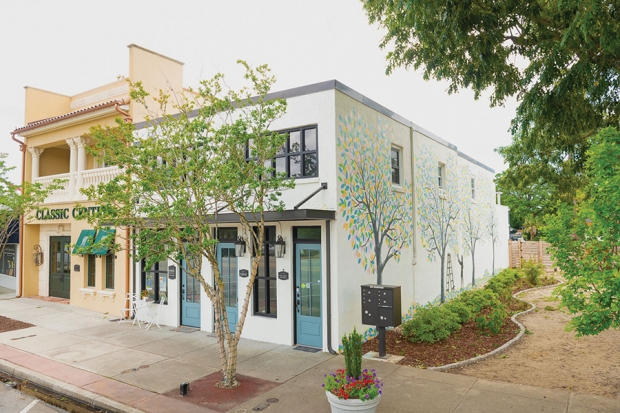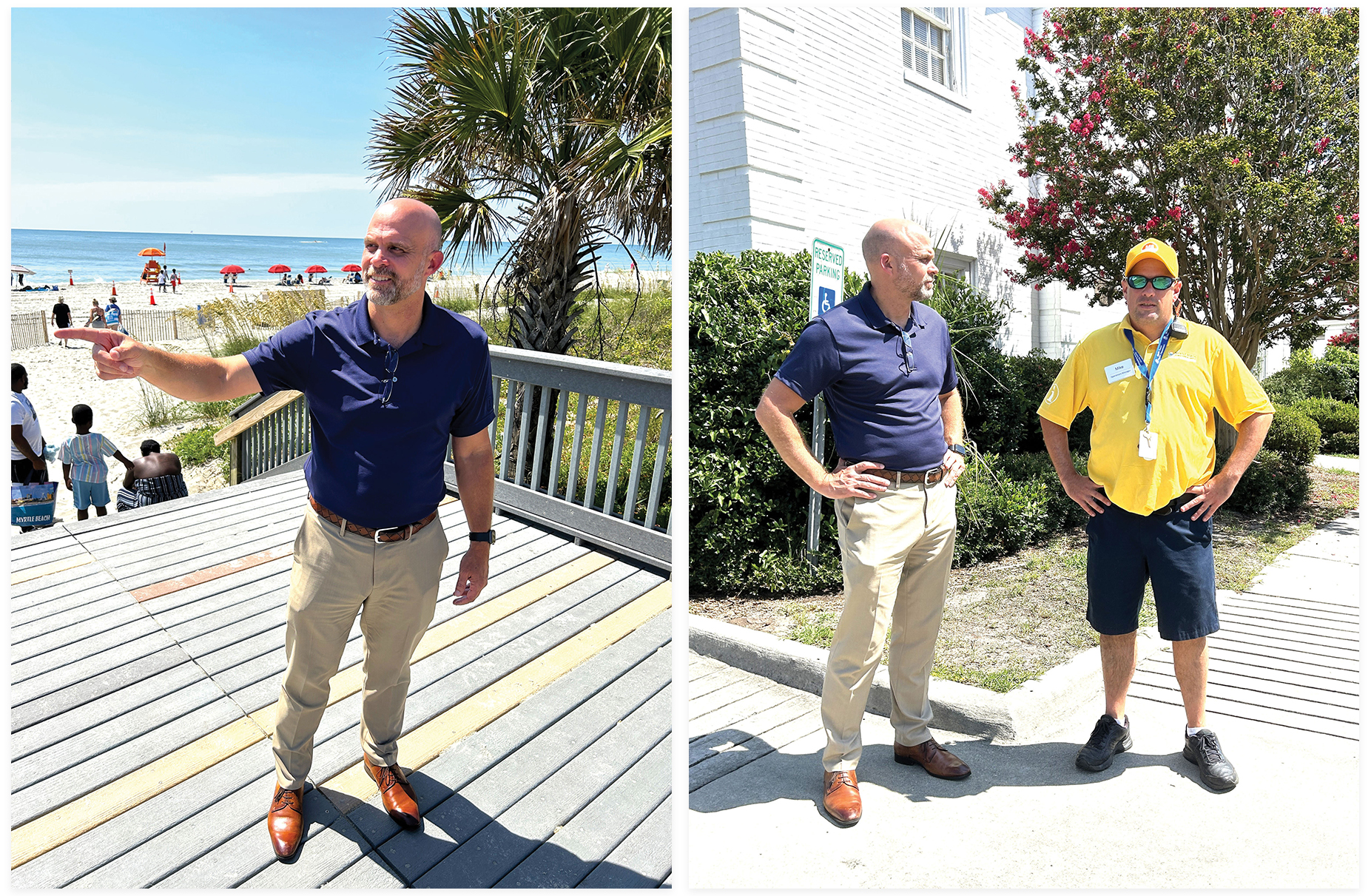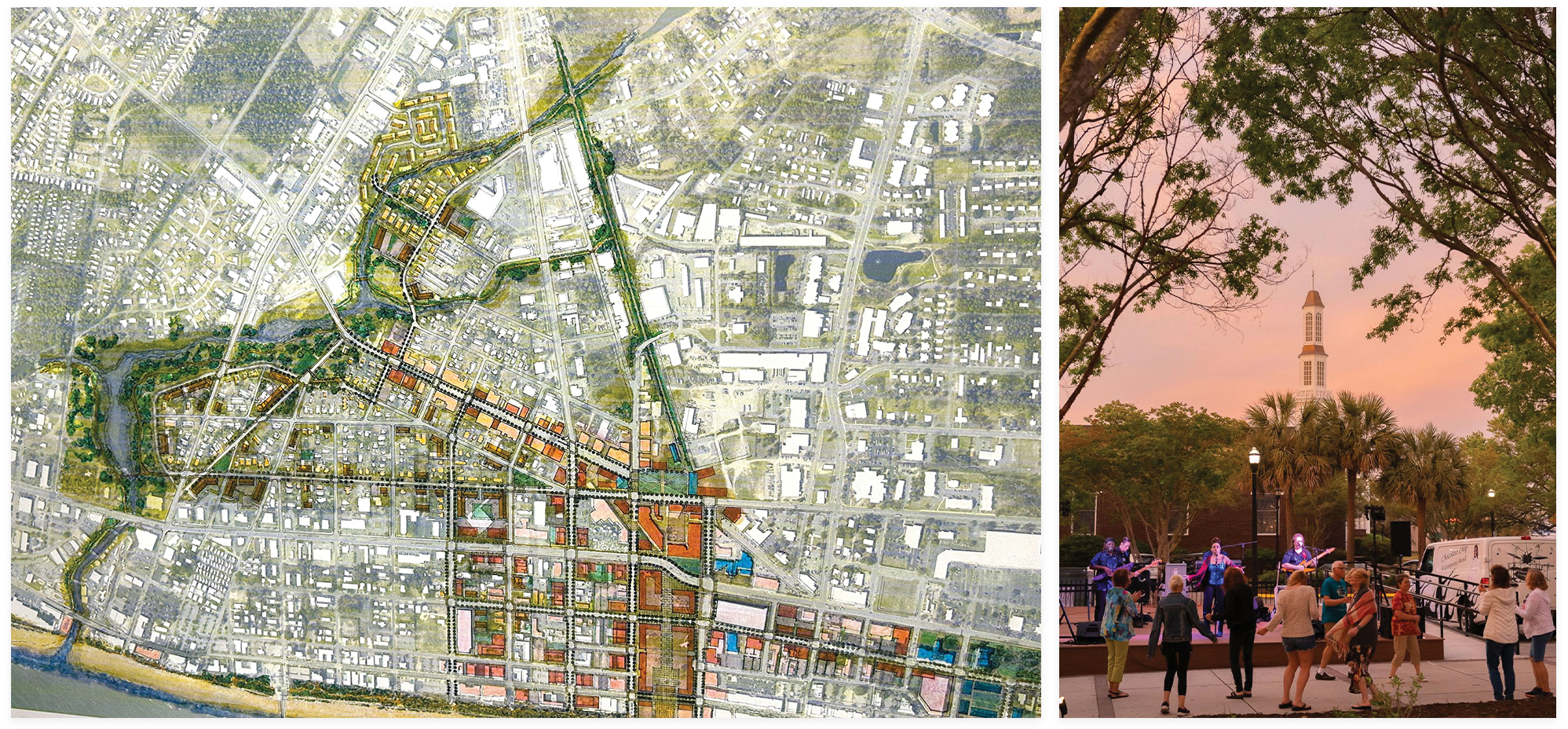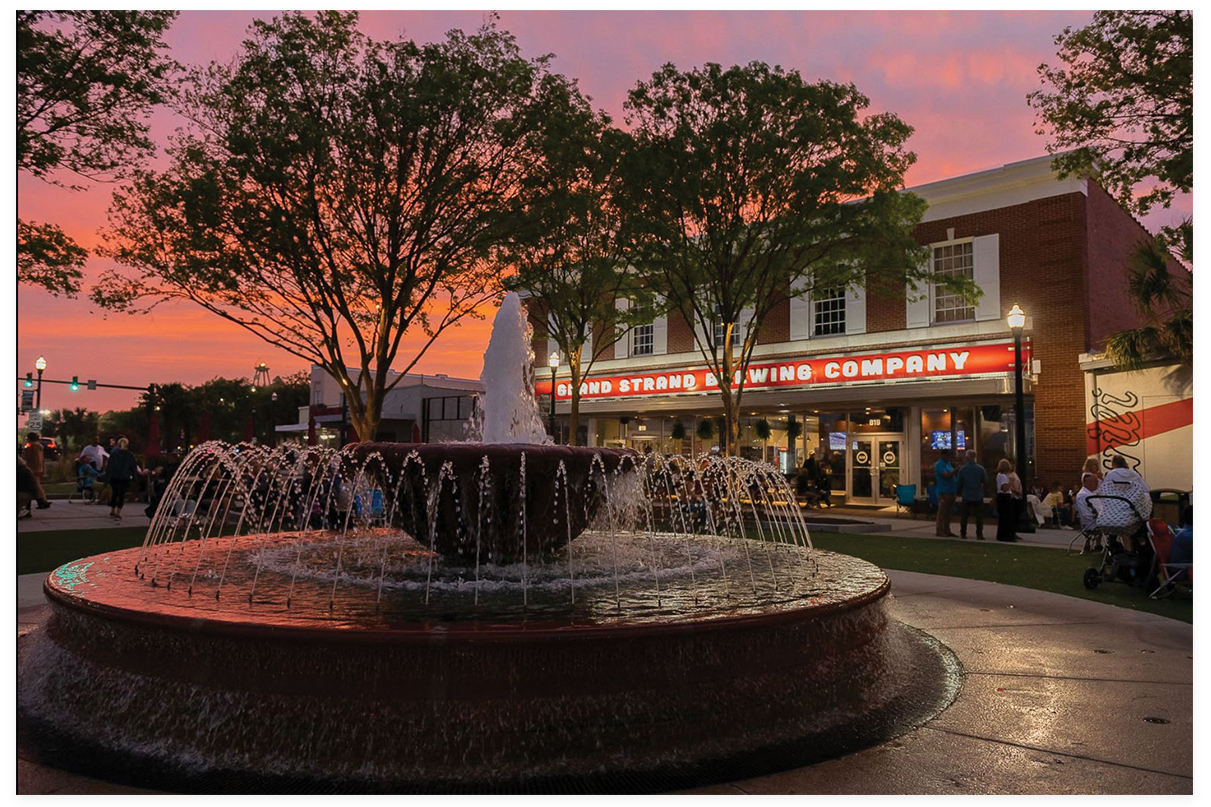A Day in the Life of Jason Greene, CEO, Myrtle Beach Downtown Alliance

On May 8, 2023, former Marine officer and recent Habitat for Humanity director, Jason Greene, was officially hired to run the City of Myrtle Beach’s enterprise dedicated to downtown revitalization, the 501 (c)3 nonprofit Myrtle Beach Downtown Alliance (MBDA). As the name suggests, the organization is a public/private partnership between the city and the businesses and residents of the area that make up a loosely defined “downtown.” As such, Greene finds his typical day may start in his Broadway Street office, but will likely send him in all directions throughout the day as the MBDA seeks to make lasting connections, to beautify, renovate, reinvigorate, and reimagine what this once-thriving part of the city might look like and might offer to the community in the next 5, 10, and 20 years into the future.
Just what might one of Greene’s typical workdays look like? I had the opportunity to tag along one morning to discuss some of the MBDA’s short-term goals and even what they dare to dream for the future.
8:05 a.m.
I meet Greene in the MBDA Office, located at 522 Broadway St. in Myrtle Beach, a treelined, picturesque part of the city. The street and its mix of businesses and nearby residential neighborhoods is in many ways emblematic of a future vision for all of downtown. International restaurants, a clock and watch repair shop, a tavern, a few nail and hair salons, and a large new restaurant, the Swig & Swine, set to open soon, all coexist in one of the oldest portions of the city dating back to Myrtle Beach’s earliest days.
The recently renovated MBDA offices are inviting, modern, but also modest, set in an older building taking up two floors. Greene had time before a scheduled 9 a.m. meeting to show me around and to touch on some of the many projects the MBDA is considering. He is passionate about aligning strategies and speaks with deliberate, almost military precision. His 12 years of active-duty deployment, much of which was spent as a helicopter pilot in some of the most dangerous, war-torn and active areas of the world, seems to have given him this ability to combine logistics with planning, and ultimately implementation.
8:37 a.m.
In a small conference room — too small for the MBDA’s large monthly board meetings, but just right for smaller sessions — Greene shows me the ‘map.’ It’s the conceptual design for the downtown area development focus, according to Greene. It was created in 2019 by a consulting firm that specializes in this kind of city planning. The outline shows what is considered “downtown” by the city and the MBDA, which is roughly the oceanfront, west to the intersection of U.S. 501 and 3rd Ave S., and north to 16th Ave N. and south to 3rd Ave S.
“Our mayor, Brenda Bethune, likes to say we have the shortest Main Street in the U.S.,” laughs Greene, referring to the actual Myrtle Beach Main St.,which is maybe 100 yards long and sits in the convoluted meeting of U.S. Hwy 501, 8th Ave N. and U.S. 17 Business.
Locals know the intersection well, and visitors wonder how this ever happened. The intersection was reconfigured a decade ago, and will undergo another more logical realigning soon, with construction hopefully starting within a year. Of particular interest to Greene and the MBDA is a Main Street that sits at the heart of the Arts & Innovation District.
“Micro districts like this are key to the future of downtown,” says Greene.
The MBDA’s vision is ever-evolving, but the future-thinkers are envisioning a plan that will make downtown the envy of small cities around the U.S. This will include new residential buildings, greenways, parks, arts, entrepreneurial-friendly co-work spaces (of which there’s already one), and more–the kind of place Greene hopes visitors and residents will gravitate toward.
Greenville and Columbia, S.C., spent time and considerable dollars revitalizing their downtowns to great effect, turning once blighted areas of their cities into crowning jewels. The MBDA hopes and plans for the same sorts of revitalization for Myrtle Beach.
8:52 a.m.
I ask Greene how he might answer critics of the downtown Myrtle Beach area in its current state, and he answered with pragmatism and honesty.
“I tell them: ‘We understand that there are some concerns, both real and perceived, that need attention, but most importantly, things are changing. This is a part of a process that takes time and the problems are complicated. [Change] won’t fall to just one organization, it requires community effort.
“The city bought a lot of these old hotels that were rundown,” he continues. “The reason they did that was because of the nuisance calls and crime around some of those properties. It was a smart move for the city in my opinion. It has created a safer environment. There’s still work to be done, of course, but clean and safe is what we should strive for and what we’re promoting.”
Grand Strand residents and visitors to downtown can’t have missed all the improvements over the past few years: new businesses and even upscale residential options, all of which were just a dream not terribly long ago.
8:55 a.m.
Fit and trim, Greene, 50, looks every bit the Marine and is up at 4:30 each morning for a workout or a brisk walk around the block. A family man with two young daughters he drops off at school each morning, he tries to keep the job a Monday through Friday, 9 to 5 endeavor, but that doesn’t always work out. There are regular after-hours planning sessions, board meetings, and events that the MBDA hosts, such as Nights at Nance, a spring through fall monthly concert series at the stage located at Nance Plaza in front of Grand Strand Brewing Co. There are First Friday Art Walks that take place the first Friday of each month, pairing local artists with participating businesses in the downtown area who will display their works and enjoy the increased foot traffic.
“I eat on the fly most of the time, grab some trail mix, whatever. I only occasionally take lunch meetings,” he says, as I leave the MBDA office to give Greene his time for a phone meeting.

10:07 a.m.
His meeting with a consultant finished, Greene and I take a short walking tour of Broadway Street. We pass a tiny Brazilian restaurant, where I had just moments earlier enjoyed strong coffee and a mysterious sugary pastry. The smiling proprietor spoke only in Spanish and used Google Translate to take my order and answer my questions. The transaction was quick and painless, and the mid-morning snack delicious.
“Broadway Street, in my opinion, will continue in this really interesting growth,” says Greene. “It’s kind of Main St. U.S.A.’ The real opportunity is adding more residential. Broadway is a kind of a small center of activity. How we connect it to other small centers of activity is part of the overall journey of developing downtown. We will be having [street] festivals and promoting the fact that this is a great place to be. We want to preserve the historic nature of downtown, while looking toward a progressive future.”
What else does the MBDA envision for downtown’s future?
“The city wants downtown to be very resident-centric,” says Greene. “We want to connect the experiential components of the area. The Arts & Innovation District is an experience in its own right. Whatever happens east of Kings Highway will be an experience.”
At the southern end of Broadway Street, just out of our eyesight, sits Withers Swash, a small natural stream that’s been a feature of the coastline for thousands of years. It currently stretches from the Atlantic Ocean, where it had been the site of a Confederate Civil War salt works, through the 57-year-old Family Kingdom Amusement Park, heading with small branches north and south to Robert Grissom Parkway. It’s an unremarkable feature of the landscape at the moment, but the MBDA has it firmly in its sights for something special.
“The city has already been focused on the Arts & Innovation District for a couple of years, but we’d like to see the Wither’s Swash project be among the first things we tackle," says Greene." The Beach to Broadway connection, in my opinion, is important to our overall goals.”
Greene and the MBDA board have been discussing turning the Swash into a greenway with boardwalks, biking and hiking trails—manicured, but still preserving the natural landscape.
“The idea behind all of this is creating these experiences east of Kings Highway, and then within the Arts & Innovation District, and along Broadway Street, with new residential areas along Withers Swash.” How are all these projects paid for?
“Our strategic plan is to develop phasing to determine what projects happen first,” says Greene, “and our strategic planning committee, and then the full board has to approve it. If and when that happens, it will go to city council for final approval. Some federal and state money will hopefully eventually flow this way, along with city funding to help us toward our goals.”
The rattle of construction on Broadway Street, a sure sign of the future, interrupted our conversation. A new roof is being installed on The Tavrne, a true local’s bar and popular lunch and dinner spot with last call at 1:45 a.m. every night. A few doors down, major construction is underway, the first on Broadway Street in many years.
“That’s the Swig & Swine,” says Greene proudly.
The Charleston-based eatery chose the 500 block of Broadway Street for its latest venture, whose Charleston restaurant was named in the ‘Top 50 BBQ Joints’ by Southern Living Magazine. But it’s not just the new businesses that are important to the MBDA’s plans.
“Local businesses are so important in this effort,” says Greene. “They’ve been trudging through the good and bad for decades and are a wealth of knowledge about what works and what doesn’t. The residents and business owners are key in what we do. I will always seek their input and will always listen to what they’re telling us about what they’d like to see and what they don’t want to see.”
10:49 a.m.
It’s time to leave Broadway St and check in on another MBDA project, the Gold Cap Ambassadors, Myrtle Beach’s full-time street ambassadors since 2019. They are charged with safety, cleaning, hospitality, and outreach. We hop in the car to visit the Gold Caps at their office, currently housed within the old First Presbyterian Church on Kings Highway, at the northernmost spot within the MBDA’s hemisphere.
Mike Snow leads the organization, started just before the Pandemic. Eventually, the MBDA was given charge to oversee and manage their contract. Snow attends the MBDA staff meetings and regularly communicates with the MBDA and the board.
The Gold Cap Ambassadors, so named for their golden-yellow shirts and hats, roam the streets of downtown Myrtle Beach and the Boardwalk helping lost tourists, reporting on any emergencies, picking up trash where they see it, and acting as an extra set of eyes and ears for the city.
“We have 140 locations throughout the country,” says Snow. “We’re here year-round. In the summer, 9 a.m. to 10 p.m. in two shifts, in the off season, one shift. We answer questions, keep an eye out for problems.”

The Gold Cap office is located in the historic building already undergoing a major transition from church to multi-use entertainment complex, and maybe eventually home to a boutique hotel.
ROAR, the name of this new venture, was announced late last year and will be housed in the 1940s-era First Presbyterian Church on Kings Highway at 13th Ave. N. ROAR will be themed to the 1920s and 1930s, with simulated golf, bowling, several bars, E-sports, an arcade, live music, DJ and more. They hope to open in Spring 2024.
11:33 a.m.
Greene and I make our way to the oceanfront at 8th Ave N., passing two Gold Caps along the way. We discuss more of the strategic plan of this complex region known as “downtown.”
“We love the Rails to Trails program and see that maybe transforming the old railroad at the Train Depot to the Intracoastal Waterway will add an exciting aspect to the downtown region," he says. "We envision being able to park your car downtown and be able to get around by bike or walking.”
“In some cases we’re looking at a 20-year timeline, other projects will start and finish sooner, of course, but we have to look that far ahead.”

Greene doesn’t make the decisions by himself or in a vacuum. The MBDA board is 21-strong and, by mandate, has three city officials, which include Mayor Brenda Bethune, City Councilman Mike Chestnut, and City Manager Fox Simmons. The rest of the board is made up of three nonprofits and local business owners. They meet monthly and Greene’s MBDA schedule includes four to six meetings per day.
“We’re a lean organization” he says, “just three of us, so we all wear a lot of hats.”
11:59 a.m.
Who is most interested in downtown Myrtle Beach?
“We give the local businesses and residents the highest priority,” say Greene. “They have decades of experiential knowledge; what works and what doesn’t. An important aspect of our strategic plan is defining the role of just what the MBDA is and hopes to do. Businesses, landowners, residents—they are our focus. We have to give people a reason to get in their cars and come down here.”
Greene has a meeting to run to, and a 3 p.m. marketing meeting with Element, a local, downtown marketing firm owned and operated by entrepreneurial photographer Carl Kerridge, who is himself a longtime business and property owner both on Broadway Street and nearby 8th Ave. N.
“If this is a place for residents,” muses Greene, “which I believe it will be, we’d like anyone coming off the beach—could be tourists, locals, or coming from the bookends of the city—we want them to experience this resident-centric, and fun, entertaining, enjoyable experience downtown, so they can see just how livable it can be.”
“We have to align ourselves with a common vision.”
Visit www.mbdowntown.org for more information.